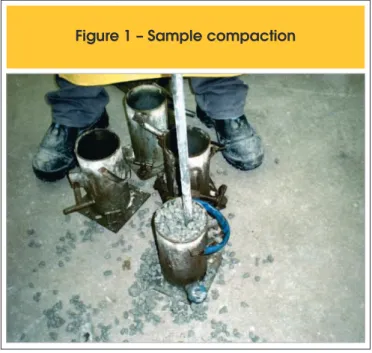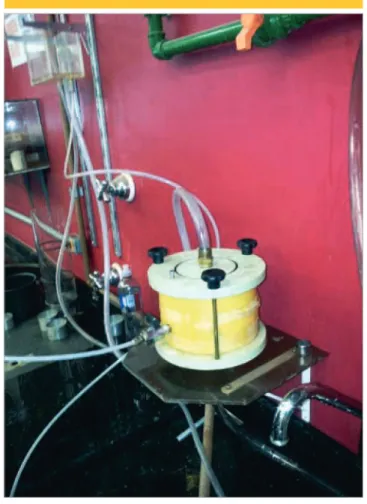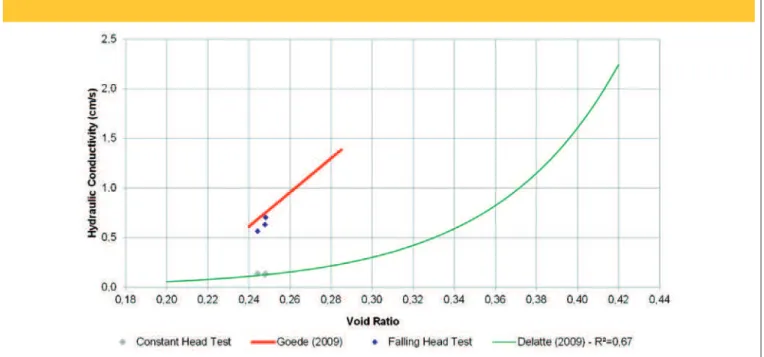Study on the hydraulic conductivity by constant and
falling head methods for pervious concrete
Estudo da condutividade hidráulica com carga
constante e variável em concretos permeáveis
a Universidade de São Paulo, Escola Politécnica, Departamento de Engenharia de Transportes, São Paulo, SP, Brasil.
Abstract
Resumo
The main goal of this paper is to show the analysis of the permeability characteristics of three different mixes of pervious concrete produced with the variation of the coarse aggregate size. Two different test methods were used to achieve the hydraulic conductivity of the samples: falling head and constant head permeability tests. Based on test results it is concluded that the pervious concrete mixes have shown to be good drainable materials. Besides, it was found that the permeability of the mixtures does not seem to depend on the size and gradation of the coarse aggregate.
Keywords: pervious concrete, permeameter, hydraulic conductivity, concrete pavements.
Este trabalho tem por objetivo apresentar os resultados de ensaios de permeabilidade realizados para três misturas de concretos permeáveis
produzidos com diferentes granulometrias, a im de determinar a variação do potencial permeável destas misturas considerando as diferentes porcentagens de agregados graúdos na sua composição. Para determinação do coeiciente de permeabilidade foram empregados dois métodos:
ensaio de permeabilidade com carga variável e com carga constante. A partir da análise dos resultados obtidos, pôde-se observar que os
mate-riais estudados apresentam muito boas características de drenabilidade e que a variação da granulometria em termos de agregados graúdos não é fator preponderante para a variação deste parâmetro.
Palavras-chave: concreto permeável, permeâmetro, condutividade hidráulica, pavimentos de concreto.
R. BATEZINI a
rafaelbatezini@usp.br
J. T. BALBO a
1. Introduction
The increasing of impermeable surface areas due to the
acceler-ated and unplanned urban development has signiicant impacts on
the hydrologic cycle, rising the peak runoff rate, which increase the
probability of downstream looding and inundation on the cities.
Those events are commonly associated to demographic explosion and the lack of urban planning by government institutions.
In recent years, an alternative hydrological control concept has gained place in the Brazilian urban drainage scenario. The Best
Management Practices (BMP) are techniques that aims to guar -antee the storm water control to be absorbed into the ground, as near as possible from its source, avoiding runoff and consequently
downstream looding. The Environmental Protection Agency (EPA)
has developed this concept in the 80s. It is based on storm water control planning in a basin scale by using civil structures in order to
temporarily store surface runoff before iniltrating it into the subsoil (reservoirs, iniltration trenches, permeable pavements), in an at -tempt to compensate the effects of urbanization.
In addition, projects involving roads, highway, bus corridors, park-ing lots and other infrastructures in large urban centers, need to consider several technical and environmental requirements rec-ommended by governmental transport agencies as well as by environmental agencies. Concerning environmental criteria, new regulations have been created in Brazil in order to restrict the per-centage of impermeable surface areas in urban projects. Usually, at least 30% of the total project area is requested to be permeable. In this context, permeable pavements systems can be considered as a simple solution, which must have mechanical and hydraulic
characteristics suficient to withstand both the trafic loads and al
-low water iniltration from the storm water into its structure, reduc -ing the runoff by almost 100%.
Permeable pavement is a structure that allows air and water to drain through its layers. This iniltration device absorbs most part
of the surface runoff into an open-graded stone reservoir placed over the subgrade. Once the water is absorbed and temporarily
stored into the open-graded base, it can iniltrates into the subsoil
depending on soil drainage characteristics, or a drainage system can conduct it to a different reservoir. The permeable pavement base and sub-base, which stores the runoff, is characterized as an
open-graded matrix with reduced amount of ine aggregates.
1.1 Justiication
In the Brazilian context, there is still no much research on the use of pervious concretes and its long-term performance, and the
num-ber of publications on this topic is scarce. Considering the poten-tial environmental and economic advantages on using this kind of material as the surface layer of permeable pavements for light and
heavy trafic compared to the other materials, it can be seen the
importance of carrying out more detailed studies on the subject, including the assessment of hydraulic conductivity of pervious con-crete. The main goal of this study is to show the results of a labo-ratorial study on the hydraulic conductivity of pervious concrete obtained by constant and falling head permeability tests. The tests was carried out on specimens produced by three different pervi-ous concretes mixtures with the variation of the coarse aggregate
gradation, focusing on determining the inluence of the gradation
on the material’s permeability.
2. Materials and experimental program
2.1 Materials, molding and curing
Cylindrical specimens of the pervious concrete were prepared in order to perform the hydraulic characterization tests. The
mold-ing procedures were conducted at Holcim Brasil laboratory at São Paulo. The laboratorial tests were carried out at Pavement Me
-chanics Laboratory and Pavement Technology Laboratory, both in the Transportation Engineering Department of the Polytechnic Schol of the University of São Paulo.
The mixture design applied on this study had been pre-set from
the literature review, since there was no speciic mix design pro -cedure for pervious concrete by the time of the study. Thus, pre-viously studied mix proportions had been considered in order to
verify how the gradation of the coarse aggregate inluences on
the hydraulic behavior of the mixtures. Three pervious concrete mixtures were produced using different coarse aggregate grada-tion, as shown in Table 1.
The cement content range to produce pervious concrete observed in literature review goes from 340 to 400 kg/m³. On this study, it was used 374 kg/m³ of cement content. The coarse aggregate content was 1.660 kg/m³ which represent 1:4,4 cement/aggregate
proportion; the water to cement ratio of 0,3 was ixed according to
other studies. Table 2 summarizes the material proportions used in this study.
The compaction molding procedure for the cylindrical samples (20 cm high and 10 cm diameter) consisted on rodding 15 times in three layers (Figure 1), followed by vibration for 10 seconds on a vibration table (Figure 2). The specimens were placed in a moist chamber at 98% relative humidity, and cured according to NBR 5738 [2]. All samples were demolded after 7 days, unlike con-ventional concrete, since pervious concrete did not show enough
249 IBRACON Structures and Materials Journal • 2015 • vol. 8 • nº 3
Table 1 – Coarse aggregate proportions
used in mixes
Mixtures % of retained material on the sieve 9.5 mm 6.3 mm 4.75 mm
M1 0 100 0
M2 0 50 50
M3 30 40 30
Table 2 – Pervious concrete mixing ratio
Materials Proportion
Cement (kg/m³) 374
Coarse aggregate (kg/m³) 1,660
w/c ratio (mass) 0.3
stable structure to be demolded after 24 hours, as recommended by the Brazilian standard.
2.2 Permeability tests
2.2.1 Falling head permeameter test
A falling head permeameter was constructed in the laboratory in order to carry out the permeability tests. The apparatus is equipped with a valve and an external level to check the water column height (Figure 3). Twelve samples were tested for each pervious concrete
mixture in order to obtain a suficient number of samples for statisti -cal analysis of the results.
During the test the samples were wrapped in plastic ilm in order
to avoid loss of water through its lateral surface. Furthermore, two silicone rings were used for sealing the bottom and the top of the samples were produced, avoiding water leaks during the tests. The tests were carried out 25 days after molding.
The test procedure consisted in adding water to the downstream end of the device to expel any air voids that may have been pres-ent in the sample. After complete sample immersion on water, the valve on the center of the permeameter was closed and the water column height was increased until 25 cm by the upstream. After opening the valve, the time to the water column height decrease from 25 cm to 5 cm was recorded. Equation (1) was used in order to determine the hydraulic conductivity of the samples.
(1)
2 1
ln
h
h
x
At
aL
k
=
In Equation (1) k is the hydraulic conductivity (cm/s), a is the cross-sec-tional area of the standpipe (cm²), L is the length of specimen (cm), A is the cross-sectional area of specimen (cm²), t is the time for water to drop from h1 to h2 (s), and h1 and h2 are the initial and inal water level (cm).
2.2.2 Constant head permeameter test
The constant head test is characterized by a constant water col-umn height during the test. In Soil Mechanics, it is usually recom-mended to use the constant head test in order to determine its hydraulic conductivity of high permeability materials (k>10-3 cm/s),
which is the case of the pervious concrete. However, all authors have published results of the falling head permeability tests in per-vious concrete, since for practical purposes such as the material
quality control in ield, the use of falling head test seems to be
simpler then the constant head, what makes it easier to compare
the results in ield with those obtained in laboratory.
Figure 1 – Sample compaction
251 IBRACON Structures and Materials Journal • 2015 • vol. 8 • nº 3
The apparatus is equipped in the bottom with a plastic ring where
de specimen is placed (Figure 4). A lexible membrane positioned
internally on the plastic ring is pressurized on the side of the sam-ples in order to avoid water leaks by its lateral during the test. The container used to produce the water pressure is provided with an inlet and an outlet of water as well as by a lower safety outlet to
prevent overlow.
The cylindrical cores were cut into four pieces in order to carry out the permeability tests, since de equipment has a 5.5 cm sample height limitation. The surface and the bottom parts of the speci-men were discarded and just the remaining top and bottom central pieces were tested.
The control of the water column height was carried out by leveling the column height up in the container, which was calibrated by the
incoming water low. It was carried out several attempts to ind the
optimal column height for the testing material in order to maintain
a laminar water low, which tends to vary with the luid velocity in
the conduit.
The test was started by placing the sample on the plastic ring and
pressuring the lexible membrane, sealing the core laterals. Then, water low was released in order to ill up the entire system with wa
-ter. The low rate was increased until column height constancy. The
water discharged was collected in a known-weight-recipient and
the time for collect 750 to 1,000 mL of water was measured. Four trials were carried out for each sample and the hydraulic conduc-tivity was calculated by the average of the obtained values. Once obtained the volume of discharge and the elapsed time for its col-lection, the hydraulic conductivity was determined by Equation 2:
(2)
t
A
h
L
V
k
.
.
.
=
In Equation (2) k is the hydraulic conductivity (cm/s), V is the vol-ume of discharge (cm³), L is the length of specimen (cm), h is the column height (cm), A is the cross-sectional area of specimen (cm²) and t is the time for discharge (s).
3. Results and discussion
Tables 3 to 6 show the test results for hydraulic conductivity and statistic data analysis. It can be observed that the average of
Figure 4 – Constant head permeameter
Table 3 – Hydraulic conductivity results
in the falling head test (cm/s)
M1 M2 M3
0.58 0.50 0.59
0.51 0.59 0.71
0.51 0.59 0.78
0.52 0.68 0.66
0.51 0.60 0.67
0.62 0.73 0.72
0.47 0.62 0.77
0.62 0.72 0.66
0.62 0.68 0.75
0.56 0.64 0.75
0.64 0.64 0.71
0.62 0.59 0.66
Table 4 – Basic statistical analysis of
hydraulic conductivity results obtained
from falling head test
Parameter Hydraulic conductivity (cm/s)
M1 M2 M3
µ 0.565 0.630 0.703
σ 0.058 0.065 0.054
cv (%) 10.21 10.32 7.68
hydraulic conductivity values were similar for all the three mixes in both falling and constant head tests, indicating that the variation of the coarse aggregate gradation used in this study does not seem to affect the drainability characteristics of the pervious concrete. This condition is explained by the void ratio resultant for the mix-tures, which also showed little variation [3], since void ratio seems to be directly associated to the drainability characteristics of
pervi-ous concrete produced without ines.
It had been observed generally low coeficient of variation for the
results (below 11%) in statistical analysis. Besides that, the results obtained by the constant head test were more homogenous, since
the coeficient of variation is lower than that obtained in the falling
head test.
It had been observed that the hydraulic conductivity obtained by the constant head test vary from 0.13 a 0.14 cm/s. These re-sults are within the range of rere-sults obtained by most authors that
studied these parameter in pervious concrete mixes, which pub-lished values ranging between 0.01 e 1.5 cm/s [4; 5].
It was also noticed that the average of the results obtained by the two tests are considerable different since the values from the falling head test were higher. This may be attributed to the differ-ence in equipment technology. In the falling head test, the sample
was wrapped in plastic ilm intending to reduce or limit the water low by its laterals. However, unlike the equipment used in the
constant head permeameter, there was no external pressure ap-plied to the cores, which may have caused a considerable loss of water by the specimen laterals, resulting in higher hydraulic conductivity values.
Figure 5 shows the variation of the hydraulic conductivity versus de void ratio variation of the two tests assessed in this study com-pared to the results published by other authors. It can be observed that the hydraulic conductivity values obtained in this study are very similar to those obtained by [6] in the case of the constant
Table 5 – Hydraulic conductivity results
in the constant head test (cm/s)
Position Mixtures
M1 M2 M3
Top
0.13 0.13 0.14
0.14 0.13 0.14
0.13 0.13 0.14
Bottom
0.14 0.11 0.14
0.14 0.13 0.14
0.15 0.14 0.14
Table 6 – Basic statistical analysis of hydraulic
conductivity results obtained from constant
head test
Parameter Hydraulic conductivity (cm/s)
M1 M2 M3
µ 0.14 0.13 0.14
σ 0.008 0.009 0.002
cv (%) 5.66 6.80 1.50
µ = average; σ = standard deviation; cv = coefficient of variation
253 IBRACON Structures and Materials Journal • 2015 • vol. 8 • nº 3
head test and void ratio around 0.25, approximately. However, [7]
obtained values ive times higher, which are equivalent to the re -sults found out by the falling head test in this research, considering a void ratio of 0.25, approximately. It must be pointed out that both former studies [6;7] used the falling head test.
4. Conclusions
This paper relates results of investigation on the hydraulic
con-ductivity of three different mixes of pervious concrete without ines
using constant and falling head permeameters. The main conclu-sions are summarized below:
n The coarse aggregate gradations does not appear to have
sig-niicant effect on the results of hydraulic conductivity of the per -vious concrete, since the values were very similar for all three mixtures;
n It was found that the coeficient of variation of the results were
small (less than 11%). Besides that, the result from the con-stant head test were less dispersed than those obtained in the falling head test;
n The differences between the dispersions in hydraulic
conduc-tivity results may be associated with the lateral coninement of the samples. The lateral sample coninement may not have
been guaranteed in the falling head test due the limitations of the permeameter.
n The hydraulic conductivity coeficients obtained in this study
are similar to those reported by other authors, and this parame-ter seems to be strongly related to the void ratio of the mixture.
5. Acknowledgements
The authors gratefully acknowledge support received by the
Conselho Nacional de Desenvolvimento Cientíico e Tecnológi
-co (CNPq) – master’s scholarship of the main author, and the
Holcim Brasil by the support on molding the samples as well as to
the Pavement Machanics Laboratory and Pavement Technology Laboratory of EPUSP.
6. References
[1] McCUEN, R. H. Hydrologic Analysis and Design. Englewood
Cliffs: Prentice-Hall. 1989.
[2] ASSOCIAÇÃO BRASILEIRA DE NORMAS TÉCNICAS. NBR 5738: Molding and cure of cylindrical and prismatic
concrete samples. (In Portuguese) Rio de Janeiro, 1994. [3] BATEZINI, R. Preliminar study of pervious concrete as pave
-ment surface layer for light vehicles parking areas. (In Por -tuguese) Master thesis, Department of Transportation
Engi-neering, University of São Paulo, 2013.
[4] SCHAEFER, V.; WANG, K.; SULEIMAN, M.; KEVERN,
J. Mix Design Development for Pervious Concrete in Cold
Weather Climates. Final Report, Iowa State University, 2006. [5] MONTES, F.; HASELBACH, L. Measuring Hydraulic
Con-ductivity in Pervious Concrete. Environmental Engineering
Science V. 23, p. 960-969, 2006.
[6] DELLATE, N.; MRKAJIC, A.; MILLER, D. I. Field and
Labo-ratory Evaluation of Pervious Concrete Pavements. Trans -portation Research Record: Journal of the Trans-portation
Research Board. v. 2113, p. 132 – 139, 2009.
[7] GOEDE, W. G. Pervious Concrete: Investigation into Struc
-tural Performance and Evaluation of the Applicability of



